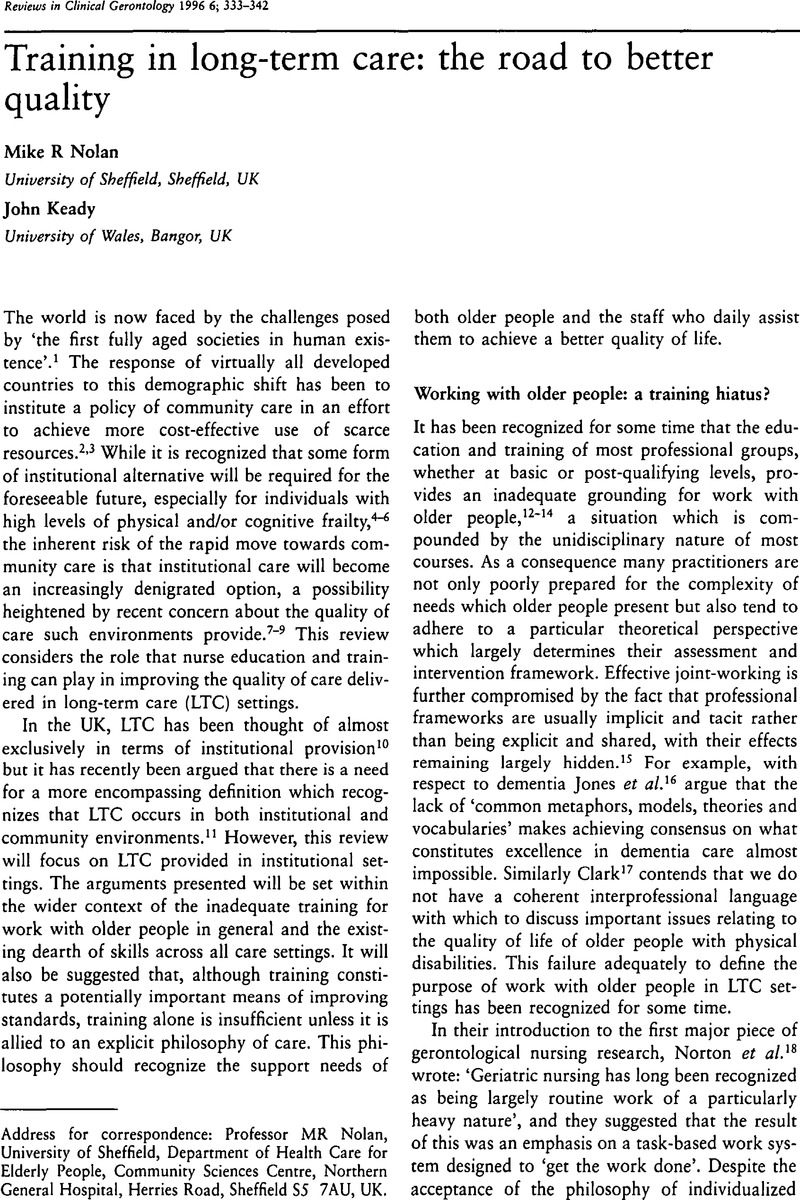Crossref Citations
This article has been cited by the following publications. This list is generated based on data provided by Crossref.
Nolan, Mike
1996.
Supporting family carers: the key to successful long-term care?.
British Journal of Nursing,
Vol. 5,
Issue. 14,
p.
836.
Davies, Sue
and
Nolan, Mike
1998.
Educating nursing home staff in the reduction of pressure sores.
British Journal of Nursing,
Vol. 7,
Issue. 3,
p.
144.
Tolson, Debbie
1999.
Practice innovation: a methodological maze .
Journal of Advanced Nursing,
Vol. 30,
Issue. 2,
p.
381.
Nolan, Mike
and
Dellasega, Cheryl
1999.
‘It’s not the same as him being at home’: creating caring partnerships following nursing home placement.
Journal of Clinical Nursing,
Vol. 8,
Issue. 6,
p.
723.
Nolan, Mike
1999.
Enhancing the Quality of Care in Residential and Nursing Homes: More than Just a Professional Responsibility.
Journal of Elder Abuse & Neglect,
Vol. 10,
Issue. 1-2,
p.
61.
Nolan, Mike
and
Tolson, Debbie
2000.
Gerontological nursing 3: valuing nursing homes and valuing staff.
British Journal of Nursing,
Vol. 9,
Issue. 3,
p.
157.
Nolan, Mike
Ryan, Tony
Enderby, Pam
and
Reid, David
2002.
Towards a More Inclusive Vision of Dementia Care Practice and Research.
Dementia,
Vol. 1,
Issue. 2,
p.
193.
Mcfarlane, Linda
and
Mclean, John
2003.
Education and training for direct care workers.
Social Work Education,
Vol. 22,
Issue. 4,
p.
385.
Fitzpatrick, Joanne M
and
Roberts, Julia D
2004.
Challenges for care homes: education and training of healthcare assistants.
British Journal of Nursing,
Vol. 13,
Issue. 21,
p.
1258.
Tolson, Debbie
McAloon, Marie
Hotchkiss, Rhona
and
Schofield, Irene
2005.
Progressing evidence‐based practice: an effective nursing model?.
Journal of Advanced Nursing,
Vol. 50,
Issue. 2,
p.
124.
Flannery, Jo
Stasi, Karen
Nolan, Mike
Davies, Sue
McKee, Kevin
and
Warnes, Tony
2005.
Experiencing training: the need for a detailed investigation.
Working with Older People,
Vol. 9,
Issue. 1,
p.
13.
Boldy, Duncan
Davies, Sue
and
Grenade, Linda
2006.
Quality of life, quality of care and resident satisfaction in care homes.
Journal of Care Services Management,
Vol. 1,
Issue. 1,
p.
66.
Hinchliff, Sharron
Goudie, Fiona
Wilson, Fiona
Cheung Chung, Man
Elford, Helen
and
McKee, Kevin
2007.
Ageing Well.
Vol. 20070544,
Issue. ,
p.
35.
Nolan, Mike
Davies, Sue
Brown, Jayne
Wilkinson, Anna
Warnes, Tony
McKee, Kevin
Flannery, Jo
and
Stasi, Karen
2008.
The role of education and training in achieving change in care homes: a literature review.
Journal of Research in Nursing,
Vol. 13,
Issue. 5,
p.
411.
Cooper, Julie
Levington, Anne
Abbott, Stephen
and
Meyer, Julienne
2009.
Partnerships for skills training in the care-home sector.
Primary Health Care Research & Development,
Vol. 10,
Issue. 04,
p.
284.
Towers, Ann-Marie
Smith, Nick
Palmer, Sinead
Welch, Elizabeth
and
Netten, Ann
2016.
The acceptability and feasibility of using the Adult Social Care Outcomes Toolkit (ASCOT) to inform practice in care homes.
BMC Health Services Research,
Vol. 16,
Issue. 1,
Parveen, Sahdia
Peltier, Carol
and
Oyebode, Jan R.
2017.
Perceptions of dementia and use of services in minority ethnic communities: a scoping exercise.
Health & Social Care in the Community,
Vol. 25,
Issue. 2,
p.
734.
Greene, Carolynn
Canning, Deebs
Wilson, Jennie
Bak, Aggie
Tingle, Alison
Tsiami, Amalia
and
Loveday, Heather
2018.
I-Hydrate training intervention for staff working in a care home setting: An observational study.
Nurse Education Today,
Vol. 68,
Issue. ,
p.
61.
Hargreaves, Claire
Tucker, Sue
Hughes, Jane
Hays, Rebecca
and
Challis, David
2019.
Specialist healthcare services for UK care home residents: a latent class analysis.
Primary Health Care Research & Development,
Vol. 20,
Issue. ,
Hendry, Louise
Taylor, Emily
and
Mackinlay, Lucie
2022.
Neuro Trauma Training: Feasibility and Acceptability of Online Training in Executive Function for Residential Childcare Workers.
Child & Youth Services,
Vol. 43,
Issue. 2,
p.
104.





